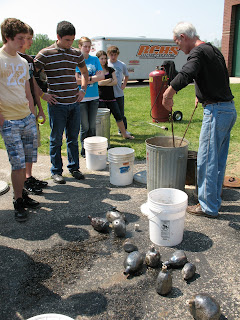 |
| Artists Name: Blake A. School: Fancher Elementary |
I know I have started many statements with, "This is the year (fill in the blank with any type of goal) will happen," only to end up later in the year feeling bummed that it did not get done.Whether it was my own procrastination or not knowing how to get whatever the goal was accomplished, my hope is that with this post and our online community of support on Facebook and Twitter, we can work together to get our goals accomplished during 2012.
So, here is to the year it DOES happen and here are a few potential Arts Education goals with suggestions on how to stay on track to fulfilling your resolutions.
- Get Hired! It is no secret that the tough economy has resulted in teacher lay-offs, pink-slips, as well as reassignments. When I originally posted this idea of resolutions our Facebook group, one member responded that their goal was to get a job this year. Although it has been a tough couple of years, there have been opportunities for Arts Ed professionals to get involved and help get their foot in the door. If you are looking for a job, consider ways to help promote your skills and expand your network by volunteering and participating in online forums. There have been various posts on our Facebook group about long term subbing positions; although this may not initially lead to a full time position, the experience and networking could.
- Get Published! Is there a great lesson plan you have that your fellow Art colleagues have oohhhed and ahhhed over and works consistently with each group of students you have taught? Then share it! We all have used resources from SchoolArts Magazine and Arts&Activities Magazine at one point or another to help gain insight and ideas to deliver and develop classroom curriculum. Make 2012 your chance to contribute. Both publications offer how-to tips with writing for their magazines. If you have ever explained a project to a friend then you will be able to write and get your work published highlighting your classroom. Nancy Walkup, the Editor for SchoolArts is also very helpful with any questions you might have about an article idea. You can follow her on Twitter, connect with her on Art Education 2.0, or follow her blog.
- Try New Tech! Whether it is flipping your classroom, creating a Twitter account, or even subscribing to some of your favorite blogs, using technology can help you connect with others in your profession and grow to help serve your students. I have only recently joined Twitter (@campbellartsoup) and have made some great strides in how I use tech in my classroom as well as connect with other teachers from across the globe. Art teacher and co-founder of The Teaching Palette, Theresa McGee, shared some great Web 2.0 tools to use, engaging students and delivering content. This takes time, but know you are not alone. There is a powerful educational community out there waiting and ready to support you through any questions you may have.
- Make Art for Yourself! Art teachers face the rare expectation compared to other content areas. You rarely hear a parent or community member ask a Math teacher what equations they are working on, but you often hear community members ask Art teachers what they have made lately. I am proud that we have a different kind of expectation, but it is often difficult to find the time to make anything when you are planning lessons, preparing materials, and displaying art for a school full of children. I became an Art teacher because I love Art and care for kids. I am definitely not the most productive artist, but I try and create work to help keep my skills honed and up to date. I am recently creating work for a group show and found that if it was not for that show, I probably would not have found the joy I have over break in making the work I have so far. Consider putting yourself into a show to force yourself to make something, or sign up for one of the Summer PD workshops the MAEA organizes.






